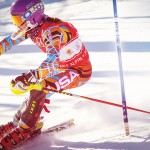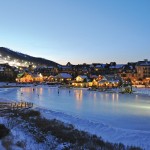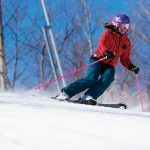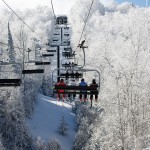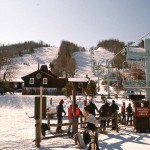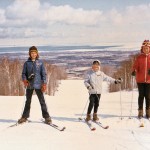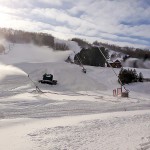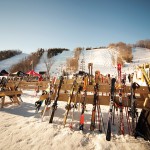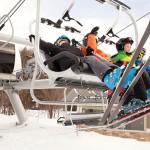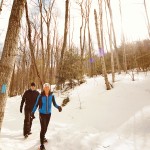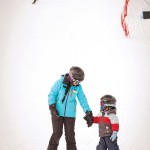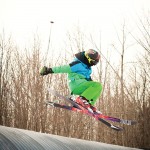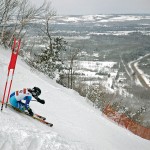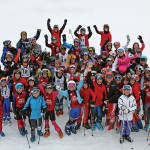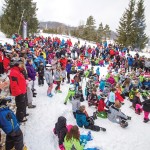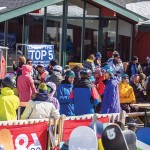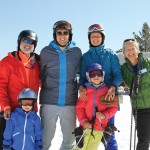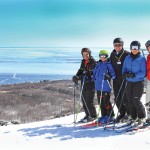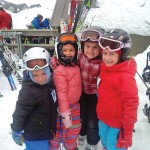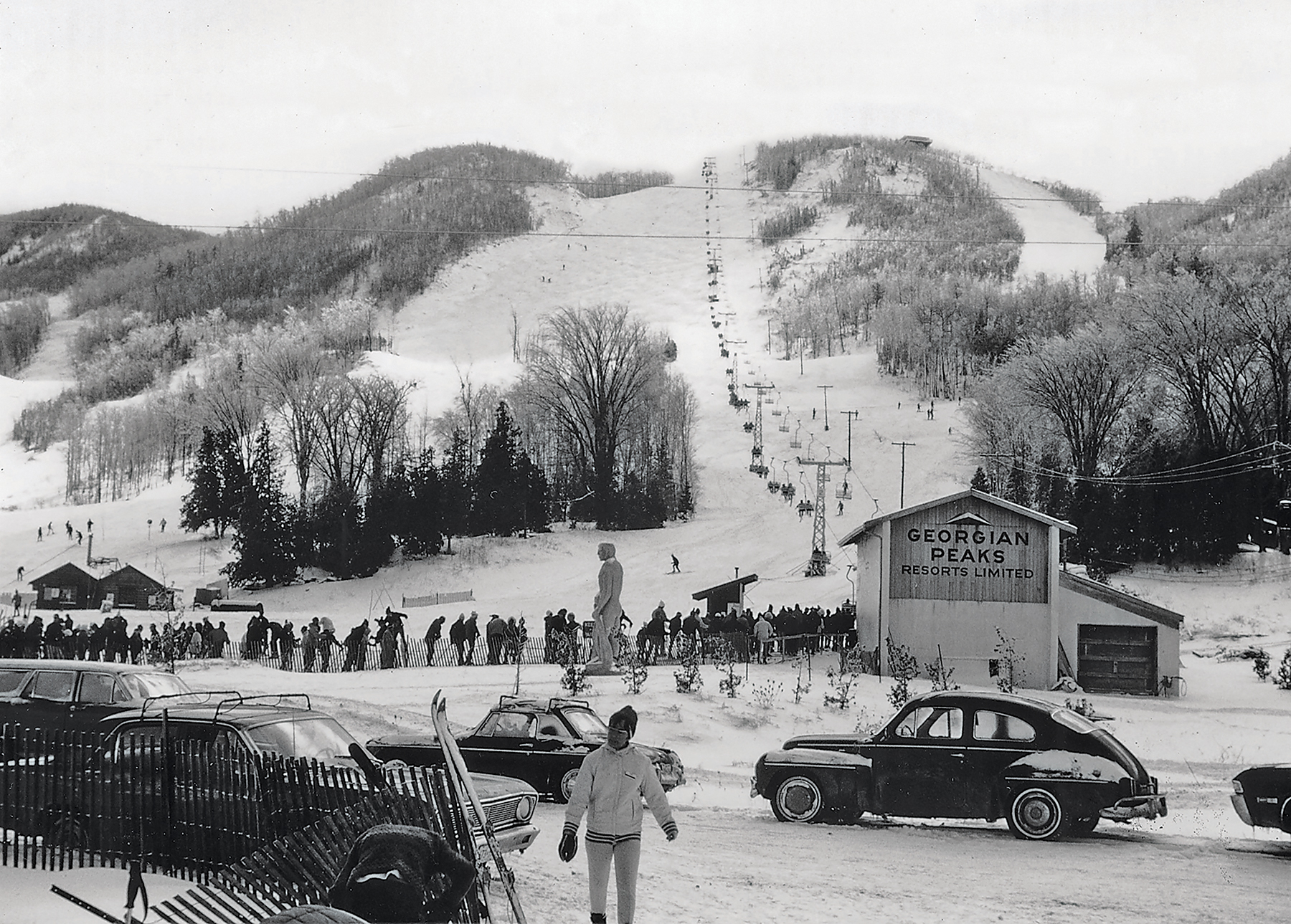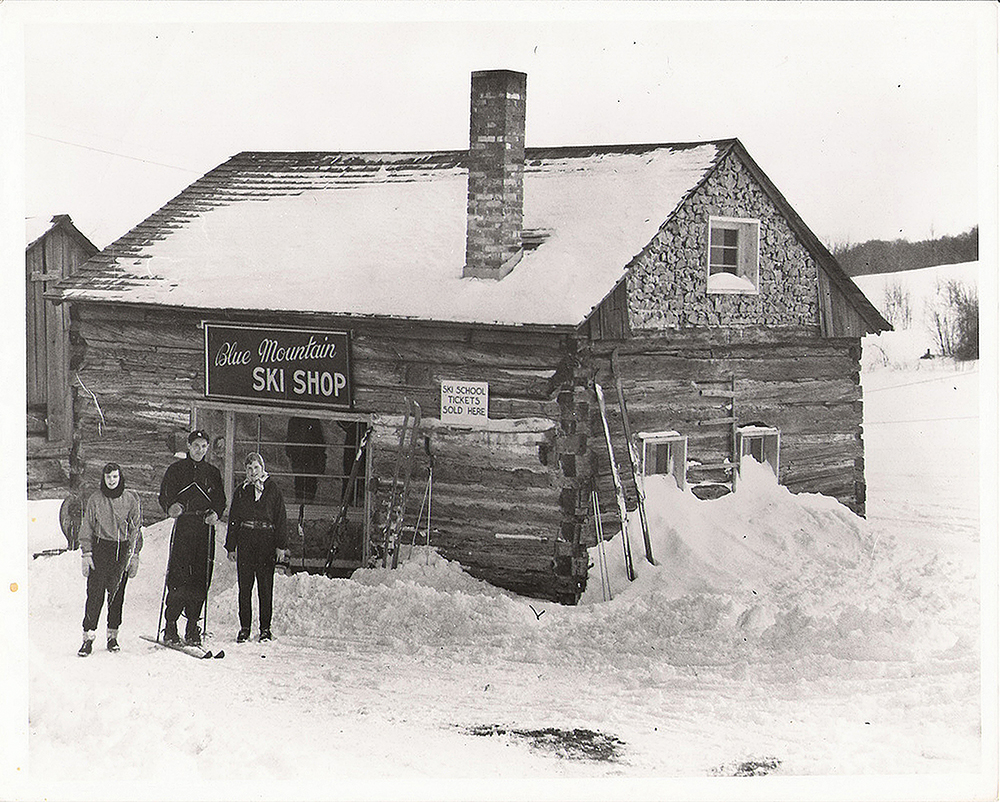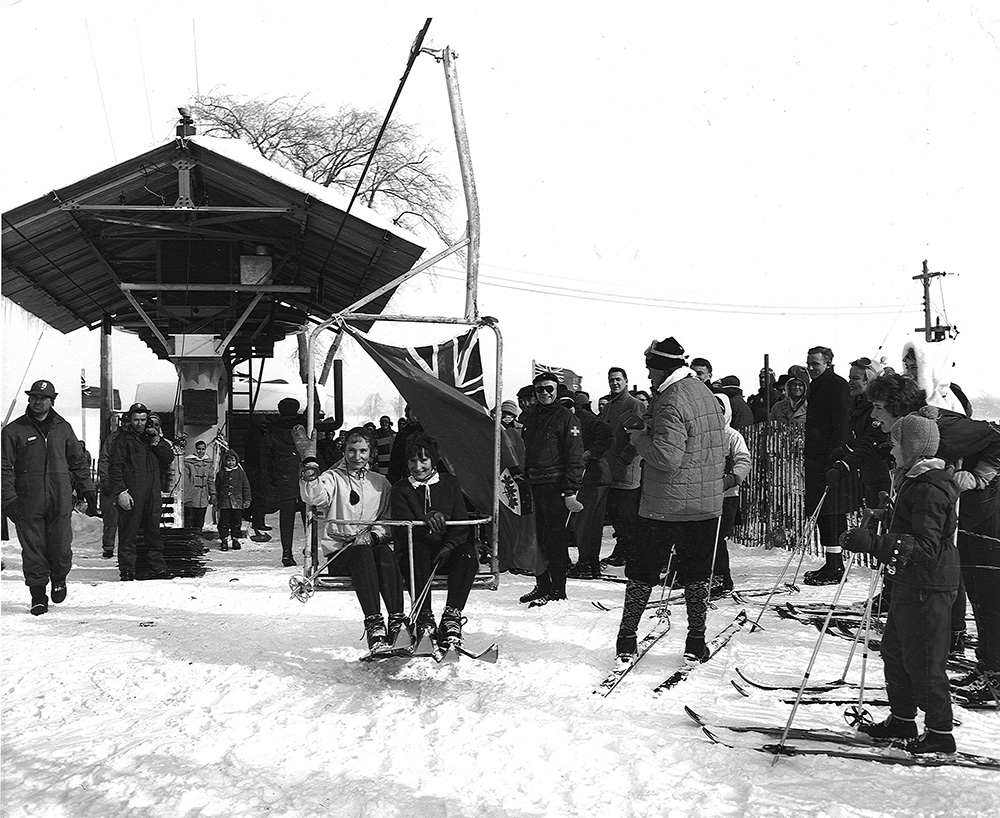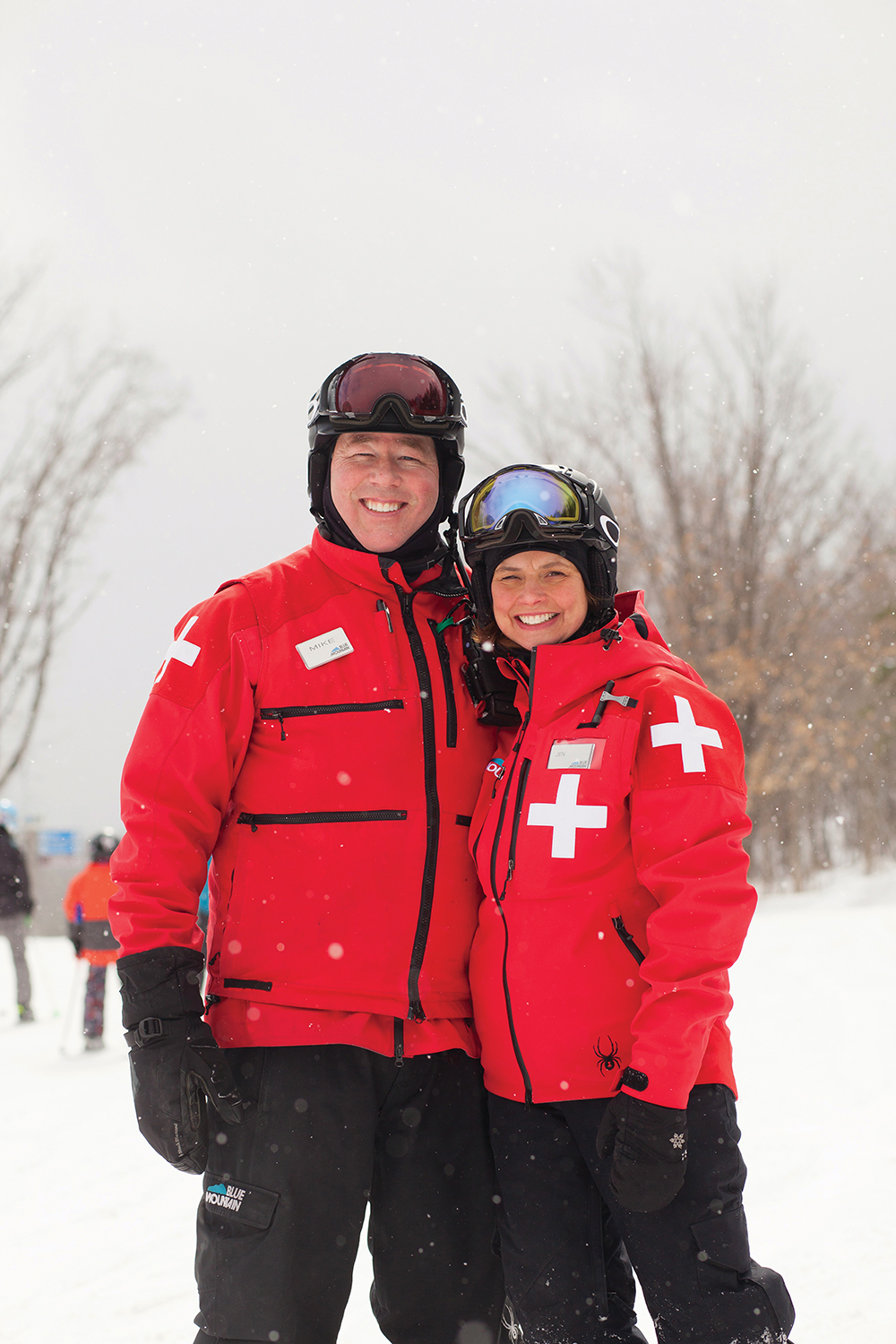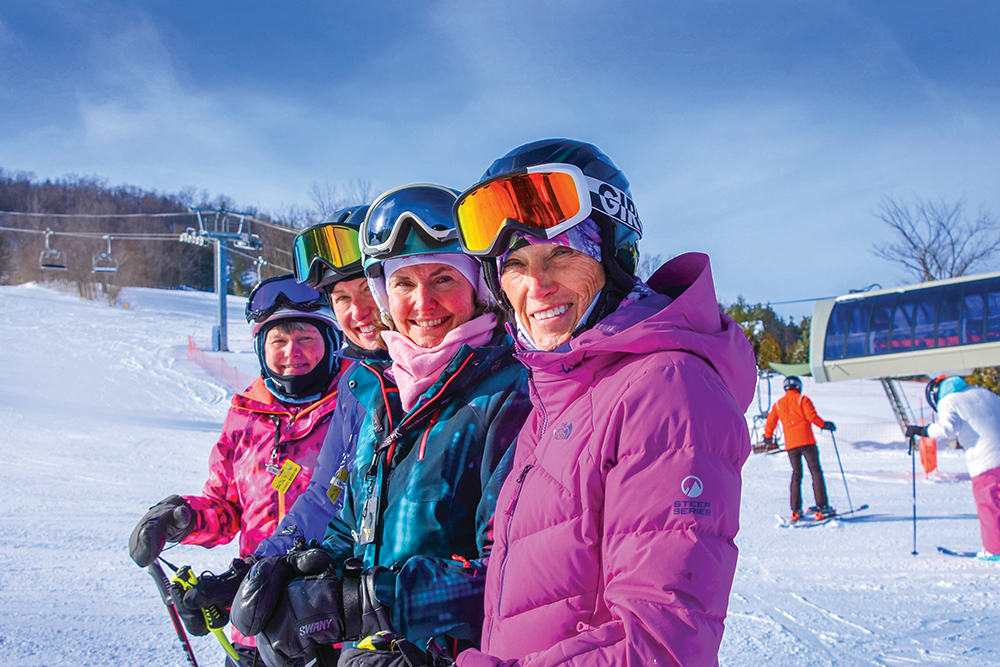Skiing’s past, present and future in Southern Georgian Bay
story by Emily Worts, opening photo by Kristie & Brenden WOODS
As a young girl I was always told, “If you can ski in Ontario you can ski anywhere.” The often icy conditions and steep terrain challenged me to the core, making up for the short runs that took mere seconds to navigate. Growing up in Midland, Ontario, on a hill where there were no chairlifts (only Pomalifts) and one snowmobile took care of the grooming, Southern Georgian Bay’s ski hills always felt like mountains.
Today, our local hills have changed what they can. Fully automated snowmaking, advanced grooming and high-speed lifts enhance what they can’t change – the length and pitch of their slopes. At all of our area ski hills, members, ticket holders, presidents and employees are quick to point out the progress that has been made over the last 75 years in the industry. However, they are equally quick to highlight that at the heart of it all everything remains the same. Skiing is ultimately about family, fun and being active in the outdoors.
Blue: Where it all Began
The biggest player on the Southern Ontario ski scene is unquestionably Blue Mountain. Drawing over two million visitors a year, Blue Mountain has placed Southern Georgian Bay on the international tourist map along with national treasures like Niagara Falls and the nation’s capital. Blue Mountain Resort will celebrate its 75th anniversary next year and Paul Pinchbeck, director of marketing, considers it a celebration of the three phases of Blue.*
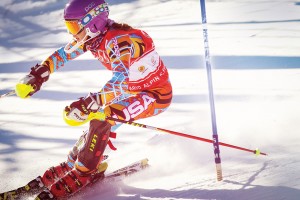
The first phase was rooted in one man’s vision: Czechoslovakian-born Jozo Weider. In the early 1940s, when the sport of downhill skiing in Ontario had few participants, Weider saw the future of not just a sport but of a lifestyle. Weider had an interesting business strategy that not everyone knows about, says Pinchbeck. In his innovative way, Weider created other businesses, like Blue Mountain Pottery, in conjunction with the ski hill, creating an economy beyond skiing but within its territory. The creation of jobs and disposable income meant more visitors to the local ski hill. By creating a highly sought-after product, in the form of pottery, more visitors were coming to the area, which ultimately meant more people skiing at Blue Mountain. It is not an unfamiliar strategy today, and we continue to see it at Blue Mountain through a diversified economy that can sustain itself in all seasons. Weider’s other visions were also groundbreaking for the area and time. In the early 1960s Weider had his own vision of a resort “village,” and by the 1980s the family secured planning opportunities to make Blue Mountain an iconic destination.
The second phase of Blue Mountain took place in the late 1990s, when the Weider family welcomed Intrawest (developer and operator of destination resorts) onto the scene by selling 50 per cent of the company. With the help of Intrawest, Jozo’s vision of a village was actualized. Blue Mountain quickly grew from a resort with a couple hundred scattered hotel rooms and condos to well over 1,000, and from two restaurants to dozens. Blue Mountain expanded its ski operations to include 42 runs, 350 acres of skiable terrain and 12 lifts, making it the largest ski resort in Ontario.
The third phase, says Pinchbeck, is the movement forward, with the Weider family selling Intrawest the remaining 50 per cent of Blue Mountain Resort in 2014. Pinchbeck says this phase will see the complete transformation of Blue Mountain into an all-season resort. For the winter season, Intrawest will continue to do what it has been doing for the past 15 years: leading the industry in chair-lifts, snowmaking and night skiing, says Pinchbeck, aligning Blue Mountain and Intrawest with Jozo’s pioneer vision.
“It has really taken off as a company and as a resort,” says Pinchbeck. “It’s a compelling product.”
Moving forward, Pinchbeck says, the resort will change and evolve with the changing face of Ontario. “The largest opportunity to grow is to move into the multicultural base,” he explains. “We all share the same core values and the love of the outdoors. Toronto compared to 50 years ago has changed.”
Skiing in Southern Georgian Bay has changed in the last 50 years as well. Fifty years might not seem that long when you consider how many advancements have been made in the industry. From steep farmers’ fields and wild forests to narrow channels of pitches, and from lifts built with a couple of sleds and old truck engines to high-speed six-passenger detachable chairs that whisk skiers up the hill in record time, the resort bears little resemblance to what it was in Jozo’s time.
Today’s High-Tech Hills
“This is not your grandfather’s ski club,” says Doug Wansbrough, general manager of Devil’s Glen Country Club. From high-tech, fully automated snowmaking to kilometres of snowshoeing trails and ice rinks, local clubs offer more bang for your buck then they ever have before.
The Glen, as it’s known by members and non-members alike, celebrated its 50-year anniversary in the 2014-2015 season. Some families at the Glen are fourth generation members and some of the staff have connections to the area dating back more than 100 years, with many of the existing employees being descendants of original settlers. “The mom of one of our employees was raised on one of our snowshoe trails,” notes Wansbrough.
This connection to place and to family is what keeps local private clubs going. Ask any president or GM of a local private club what their main focus is and they will tell you, family and community.
“We have a great product,” says Wansbrough of the area’s ski industry. “What other winter sport can have three generations of participants? Everyone can play together; you don’t have to sit and watch. Everyone is on the snow.”
Wansbrough likens being a member of a local club to cottaging in the winter, with the added bonus that this cottage experience lasts 12-16 weeks, a lot longer than our split-second summers. To make the season all that it can be and to ensure the best conditions, area ski hills have had to continually invest and reinvest in what many industry players call “snow farming.” In the early days people relied on what nature gave them, but today that’s just too risky, and like everything else, people want and expect more. Snow farming has come to include not just more snow and the grooming of it, but a diverse range of snow catering to various levels of skiers and their demands.
“The ’90s were the age of lift advancement,” says Wansbrough. “The 2000s are all about making snowmaking high-tech.”
Jeff Courtemanche, general manager of Craigleith Ski Club, has been working at the club for 26 years and says Craigleith has invested in the most sophisticated snowmaking in Canada, “without a doubt.” “We began our snowmaking expansion in 1992. It was a leap forward, investing in automation and technology,” says Courtemanche. “We had an early start and we are continually building on it and continually improving it to make it the most efficient it can be.”
By next year, says Courtemanche, Craigleith will have fully automated snowmaking. “One man and a computer will be able to run the entire snowmaking operation.” From that computer, the “snow farmer” is not only able to put an entire layer of snow over Craigleith’s 175 acres of skiable terrain at once, but can also choose what kind of snow to lay on which trails. With 20 different qualities of snow (from light and fluffy with no moisture content to heavy, ‘snowball-making snow’), snow farming is both an art and a science. “Through automation we can make heavier snow for racing and lighter snow for beginners,” says Courtemanche. “On each trail the snow can be tailored, depending on what we want to do.”
Advancements in snowmaking also mean that more trails open earlier and operators are able to maintain the condition of their trails throughout the season, translating to more days on the snow. There is competition between clubs every year to see which will be the first to open, earning bragging rights. “We were the only ski club to open in November last year, two or three weeks before the other clubs,” says Courtemanche proudly.
From an earlier start, the ski season now extends well into spring, with operators running out of skiers before they run out of snow. But more than just lengthening the season, technology is also used to enhance the on-hill experience. Ontario ski hills may not be high, but they produce some of the world’s best skiers, who have grown up skiing in some of the most challenging conditions.
Diverse Demographics
The Georgian Peaks Club is best known for its terrain. is best known for its terrain. “We’re long and we’re steep,” says general manager Mark Woodburn.
With 820 vertical feet, the Peaks offers the highest skiing in Southern Ontario and produces some of the best skiers in Canada. Out of the eight women on the Canadian Alpine ski team, three are from Georgian Peaks.
“We have a long history of putting skiers on national teams,” says Woodburn. “Our young athletes are living proof when you learn to ski here (Ontario) you can compete anywhere in the world.” The Peaks may be one of the smallest clubs along the Escarpment, but its Alpine racing program is the largest in the area. With over 800 kids and youths enrolled in programs during the season, it’s no wonder that at least a handful of them end up on top.
But skiing isn’t just for the young. In the 36 years Jeff Conn has worked at Osler Bluff Ski Club, he has seen new members of all ages join the club while the aging demographic takes to the slopes with increased vigour and enthusiasm. Conn, general manager of Osler, guesses his club has at least 120 members over the age of 80, including a 94-year-old member who still races in the club championships every year.
Last year Conn had the privilege of skiing with three members all over the age of 90. “These guys had all been skiing at the club since the 1950s and I asked them, ‘what do you think has changed?’ They all agreed, diet, health, education and lifestyle,” recalls Conn. “Twenty to 30 years ago people hung up their skis at 70,”
“Now we’re seeing people in their 80s and 90s on the hills. Many of our senior members take exercise very seriously. Skiing is an important part but fitness is as well.”
But it’s not just about fitness, admits Conn. Osler conducted a membership survey last year and one quote from a senior member said it all: “I used to ski to stay fit, and now I stay fit to ski.”
Ski boots are more comfortable, skis are easier to use, snow conditions are better, the lifts are faster and lineups are virtually non-existent – all of which make the sport more enjoyable. “People used to come up to the area and ski hard from 8 a.m. until 4 p.m.,” says Conn. “The lifts were slower and people were standing in line a lot more. People would make 30 or 40 runs in a day. Now they can do that in half a day, having skied all the vertical they want.”
These advancements mean area hills have had to diversify. With high-speed detachable lifts making it possible to get in a full day’s skiing by noon, lunch time at any of the local clubs sees dozens of members trading in their skis for snowshoes or Nordic gear. “I often see 150 people heading out for an afternoon snowshoe or cross-country skiing on our lower trails,” says Conn.
If you’re done skiing for the day, you no longer have to be “trapped in the lodge,” and if you don’t ski, there are lots of other options these days. Osler not only has 25 kilometres of snowshoe trails and a track setter that grooms 15 kilometres of Nordic trails; the club also grooms a one-kilometre skate skiing trail around its reservoir and has installed a chilled ice rink complete with a Zamboni for afternoon games of shinny and evening free skates.
It’s all about the Après
Another way to keep people entertained at local clubs is of course the ‘après’. After all, skiing isn’t for everyone, and to attract more members, clubs are not only adding snowshoe and Nordic ski trails – they are also amping up their après ski programs. “Fifty percent of the reason people join is for the social,” says Kim Giffen, marketing and communications manager of Beaver Valley Ski Club (BVSC).
In the early days of area ski clubs, members often created their own social events. Now it’s up to the club to create the social scene. From magic shows for the under 10s, rail jams for the under 18s and local musicians and après drinks and snacks for those of age, there is something for everyone when it’s time to call it a day.
Beaver Valley Ski Club is its own little village. Unlike the Collingwood area ski clubs, which compete with dozens of restaurants and bars in surrounding towns, BVSC is a one-stop shop for its members. “We’re a real getaway, a hidden gem,” says Giffen. “We’re secluded out in the valley. People love to escape here.”
“We’re a real getaway, a hidden gem,” says Giffen. “We’re secluded out in the valley. People love to escape here.” The original clubhouse at BVSC still stands, with numerous additions and renovations made over the years. It is here that the BVSC offers après ski events for kids and adults, along with fundraising galas and a New Year’s Eve family après and toast followed by fireworks. Outside, after the lifts have stopped turning, there is family tobogganing on the meadow every Saturday night, and night skiing on the Saturday night of Family Day Weekend.
Andy Lee, general manager of the Toronto Ski Club (TSC), agrees that the social aspect of any club enhances morale and spirit among its members, both on and off the hill. “You can’t just have great alpine programs; you have to have great social programs as well,” he says. “Members are giving their time to invest into the club,” says Lee. “Many of the events are run by members, and they make the club enjoyable and successful.”
Because the TSC is affiliated with Blue Mountain, the on-hill expenses aren’t as high as some other clubs, says Lee. This translates to lower membership dues, attracting new members to the club. “We have a lot more multicultural families and younger families joining,” he notes.
Family Fun
As any ski hill manager, operator, director or president will tell you, family is one of the main reasons people participate in the sport. Grant McEwen married into the Alpine Ski Club. His wife has been a member there since she was four, and McEwen, who is now president, has skied at the club for the past decade.
McEwen describes Alpine as a “utopic family environment” and says the club promotes itself as an outdoor, healthy, active lifestyle club.
It is not uncommon to see grandparents out skiing with their grandkids, to see kids taking advantage of a diverse range of programs, including racing, all-terrain and snowboard lessons, or to see members of all ages just lounging in the lodge.
At the Collingwood Ski Club (CSC) it is about more than just family; it is about local families. The CSC was originally called the Blue Mountain Ski Club when it was formed by local residents in the 1930s. However, by the end of that decade it changed to the name it keeps today (although membership extends beyond Collingwood to include principal residents of the Town of the Blue Mountains, Clearview and Wasaga Beach). The club’s A-frame lodge is a no-frills venue with kitchen space but no one there to cook; that is up to the members. This means that it is really like a home on the hills for its membership; a place to make breakfast in the morning, read by the fire in the afternoon, and enjoy the camaraderie after the runs have closed.
“Our focus is on families,” says Mary Gibson, president of the CSC, “and to encourage local use and to ski.” The club is completely volunteer run, which means members are expected to shovel the walkway if there is a heavy snowfall, and to make sure there is always hot coffee in the pot. Mid-week the clubhouse is chockablock with the retired set, and on the weekends it’s almost like a different club, with families having the run of the place, says Gibson.
Wednesday nights also see a lot of families taking advantage of Blue Mountain’s on-hill programs. “Wednesdays are busy evenings,” says Gibson. “You might see families making and having dinner here after programs, before they go home.”
The CSC’s nominal club fees give access to the clubhouse and parking; it is up to members to buy their own hill passes through Blue Mountain. It’s not surprising that the club has a two- to four year-wait list considering its affordability and its active social program, which includes popular men’s and ladies’ ski days along with Kids’ sleepovers, euchre nights and potlucks.
Unlike the CSC, most clubs, with their hefty initiation fees and annual membership dues, are working hard to attract new families. Continual investment and renewed membership is the only way to ensure these not-for-profit playgrounds continue to operate for generations to come.
Although the average age at which adults join the clubs has increased from the mid-30s to the mid-40s – due to people beginning their families later as well as a changing economy – it is the young family the clubs are targeting. This makes sense for a sport rooted in family, sending skiers aged two to 92 on runs that last only seconds but build memories that last a lifetime.
From early on, dreamers like Jozo Weider recognized Southern Georgian Bay as a place not to endure winter but to embrace it, whether zipping down the perfect fall line on fresh corduroy, cutting through a forest trail on perfectly waxed Nordic skis, or cutting across a frozen pond on sharpened blades, followed by a well-earned toddy in a warm and collegial environment. In Southern Georgian Bay we can have it all, and if we want, we can have it all in one place. With advanced technology we can play God with the weather, creating perfect powder we can carve through from November to April. Our increased overall wellness means the ski hills are no longer just for the young but also for the young at heart. In an atmosphere where family and friendships reign supreme, there is something for everyone both on and off the ski hill – it’s just a matter of stepping out to see what our hills and clubs have for you to enjoy. ❧
* Editor’s Note: As this issue of On The Bay was going to press, Paul Pinchbeck left Blue Mountain Resort to take on a new role as president of the Canadian Ski Council (CSC). His replacement at Blue Mountain had not been announced at press time; however, his comments for this story remain relevant and are drawn from his 11 years’ experience as director of marketing for Blue Mountain Resort.






